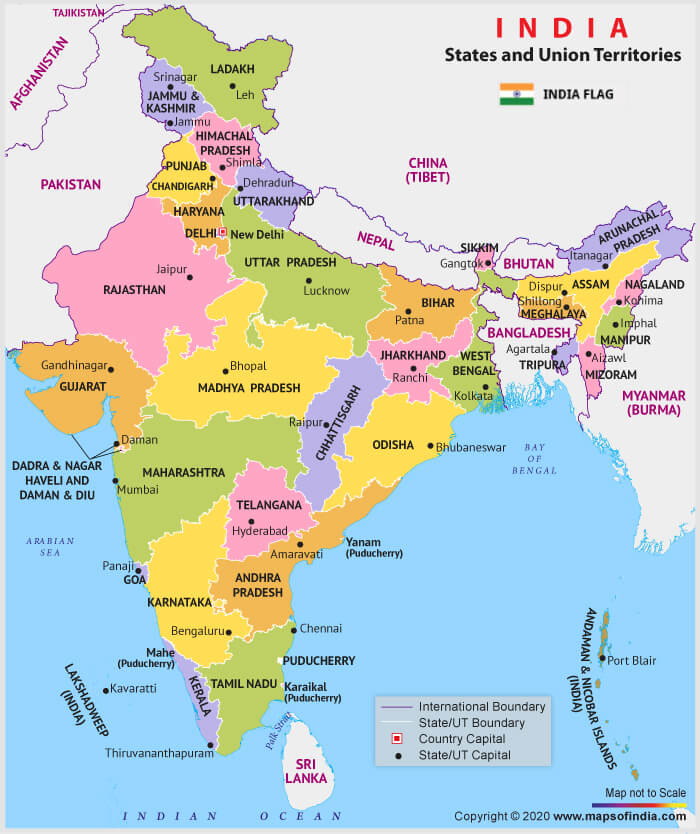India is seventh largest country in the world and also the second populous. It lies in southern Asia. It is officially known as the Republic of India. It is governed by a parliamentary form of government. It gets very difficult to manage the large country from one place. So Indian Constitution give right to the central government to make states as it feel suitable. This article talks about the list of States and Capitals of India with the founded year.
States and Capitals of India 2020
How many states are there in India?
Do you know the answer of question asked above (how many states are in india?)? if not, this article is for you. Many people don't no about the total number of States / Union Territories in India and their capitals. In this article, we are giving you the latest update on States and Capitals of India. There are a total of 28 states and 8 union territories in India at present. Each state of India has an administrative, legislative and judicial capital some state all three functions are conducted in one capital. Every state is ruled by a Chief Minister. Here we have covered the list of the Indian States, Union Territories, and their capitals.
List of States and Capitals of India
As a responsible citizens we should know about the States and capitals of India. The states and the capitals are very commonly asked as the General Awareness Questions in a number of competitive exams held all over the country. The 28 Indian States and their capitals are as follows.
States and Capitals of India 2020
| S.No | States Name | Capital | Founded on |
|---|---|---|---|
| 1 | Andhra Pradesh | Hyderabad (Proposed Capital Amaravati) | 1 Nov. 1956 |
| 2 | Arunachal Pradesh | Itanagar | 20 Feb. 1987 |
| 3 | Assam | Dispur | 26 Jan. 1950 |
| 4 | Bihar | Patna | 26 Jan. 1950 |
| 5 | Chhattisgarh | Raipur | 1 Nov. 2000 |
| 6 | Goa | Panaji | 30 May. 1987 |
| 7 | Gujarat | Gandhinagar | 1 May. 1960 |
| 8 | Haryana | Chandigarh | 1 Nov. 1966 |
| 9 | Himachal Pradesh | Shimla | 25 Jan. 1971 |
| 10 | Jharkhand | Ranchi | 15 Nov. 2000 |
| 11 | Karnataka | Bengaluru (formerly Bangalore) | 1 Nov. 1956 |
| 12 | Kerala | Thiruvananthapuram | 1 Nov. 1956 |
| 13 | Madhya Pradesh | Bhopal | 1 Nov. 1956 |
| 14 | Maharashtra | Mumbai | 1 May. 1960 |
| 15 | Manipur | Imphal | 21 Jan. 1972 |
| 16 | Meghalaya | Shillong | 21 Jan. 1972 |
| 17 | Mizoram | Aizawl | 20 Feb. 1987 |
| 18 | Nagaland | Kohima | 1 Dec. 1963 |
| 19 | Odisha | Bhubaneswar | 26 Jan. 1950 |
| 20 | Punjab | Chandigarh | 1 Nov. 1956 |
| 21 | Rajasthan | Jaipur | 1 Nov. 1956 |
| 22 | Sikkim | Gangtok | 16 May. 1975 |
| 23 | Tamil Nadu | Chennai | 26 Jan. 1950 |
| 24 | Telangana | Hyderabad | 2 Jun. 2014 |
| 25 | Tripura | Agartala | 21 Jan. 1972 |
| 26 | Uttar Pradesh | Lucknow | 26 Jan. 1950 |
| 27 | Uttarakhand | Dehradun (Winter) Gairsain (Summer) | 9 Nov. 2000 |
| 28 | West Bengal | Kolkata | 1 Nov. 1956 |
At Present India has 8 Union Territories and 28 States. The erstwhile state of Jammu and Kashmir has been bifurcated into two Union Territories (UT) of J&K and Ladakh. The newly formed union territories have been formed under a reorganization act passed by the Parliament on 5-6 August 2020. At present India has 8 Union Territories.
| Union Territories Names | Capital | Founded on |
|---|---|---|
| Andaman and Nicobar Islands | Port Blair | 1 Nov. 1956 |
| Chandigarh | Chandigarh | 1 Nov. 1966 |
| Dadra & Nagar Haveli and Daman & Diu | Daman | 26 Jan. 2020 |
| Delhi | New Delhi | 9 May. 1905 |
| Jammu and Kashmir | Srinagar (Summer) Jammu (Winter) | 31 Oct 2019 |
| Lakshadweep | Kavaratti | 1 Nov. 1956 |
| Puducherry | Pondicherry | 1 Nov. 1954 |
| Ladakh | Leh | 31 Oct 2019 |
States and Capitals of India Map
You can check the latest political map of India which provides the total number of states + union territories in India and their capitals as of July 2020.

After getting the list of Indian States & Union Territories with its capitals, let us first understand how to segregate the a state from a union territory. Out of the eight union territories in India, three union territories have their own legislatures these are Delhi, Puducherry (formerly Pondicherry) and Jammu and Kashmir. Each union territory and state has a capital of its own.
| State | Union Territories |
| The state has its own administrative units with their own elected government. | Union Territories are constituent units which are controlled and administered by the Central Government. |
| Executive Head is the Governor | Executive Head is the President |
| The relationship with the Centre is Federal. | Unitary with the Centre. i.e. all the powers rests in the hands of Union. |
| Administered by the Chief Minister and elected by the people. | Administered by the Administrator which is appointed by the President. ( except Delhi, Puducherry and Jammu & Kashmir) |
| Chief Minister is the real head. | Lieutenant is the real head |






0 Comments